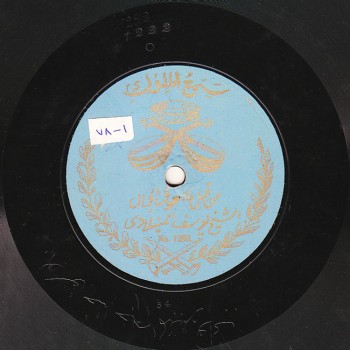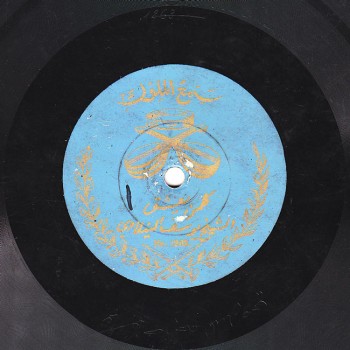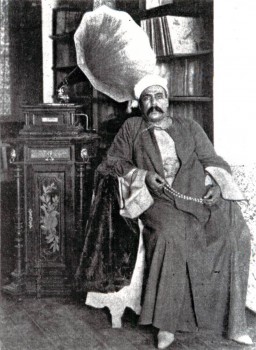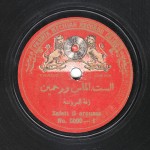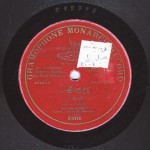The Arab Music Archiving and Research foundation (AMAR), in collaboration with the Sharjah Art Foundation (SAF), presents “Sama‘ ”.
“Sama‘ ” discusses our musical heritage through comparison and analysis…
A concept by Mustafa Said.
Dear listeners,
Welcome to a new episode of “Sama‘ ”.
Today, we will resume our discussion about dawr al-naẓīr or dawr al-mu‘āraḍa.
We finished talking about dawr “Min abli mā ahwa el-gamāl” and dawr “Kull mīn yi‘sha’ gamīl” and now have an idea about both: we can see the similarities, or why we consider these two dawr as dawr al-naẓīr.
In today’s episode, we will start with the oldest recording every time, i.e. with “Min abli mā ahwa el-gamāl” before “Kull mīn yi‘sha’ gamīl”.
Let us listen to the first sentence of the madhhab in both dawr…
(♩)
We have heard both dawr interpreted by several performers.
They both follow almost the same pattern…
Because a person who composes a naẓīr to another dawr is not imitating like a parrot. He is not affixing the same melody onto other lyrics such as in qadd. His work is only inspired from the previous work. We will thus notice that the way Dāwūd Ḥusnī completed the madhhab is different from al-Qabbānī’s version.
Such as in …
(♩)
Great.
Dāwūd Ḥusnī, after finishing the madhhab of the dawr, i.e. the part that is supposed to be the first tafrīd before the mujāwaba, remained within the ordinary pattern of a dawr: the lyrics of the dawr are repeated with the same melody of the madhhab’s beginning.
Whereas Ibrāhīm al-Qabbānī went outside this ordinary pattern –where the first sentence of the tafrīd is composed to the same melody of the madhhab’s beginning– and composed another melody for the tafrīd.
Let us listen to Ibrāhīm al-Qabbānī…
(♩)
He made a change…
Now let us listen to Dāwūd Ḥusnī…
(♩)
He repeated the same melody of the madhhab with new lyrics in order for the one who will perform tafrīd to build upon it.
Note that Dāwūd Ḥusnī later followed the same course as Ibrāhīm al-Qabbānī by composing a new melody for the dawr. He did not abide by the same melody of the madhhab’s beginning, which constitutes a dominant characteristic in the dawr he composed for Umm Kulthūm –will talk about this in detail, as well as about the composers who followed other directions in dawr in an episode with dawr composers… persons who went on composing dawr.
In Dāwūd Ḥusnī’s dawr, the first tafrīd to the bayyātī “Lamā inta mush add el-hawa, bass ti‘sha’ lēh” following the madhhab has a naẓīr in Ibrāhīm al-Qabbānī’s melody following the madhhab “Yā albī mālak we-el-hawa, mā kunti khāliṣ fī na‘īm”.
Let us listen to both…
(♩)
…Followed by an ascension in the hank in the mujāwaba or dialogue between the individual performer and the ensemble.
Let us listen to this part to the jahārkāh…
(♩)
Dāwūd Ḥusnī surely meant to be influenced by Ibrāhīm al-Qabbānī.
Now the conclusion, in both versions, to the shūrī…
(♩)
Both concluded to the shūrī…
So, it was either out of friendship or out of respect –knowing that Ibrāhīm al-Qabbānī was older than Dāwūd Ḥusnī– that Dāwūd Ḥusnī created a naẓīr to Ibrāhīm al-Qabbānī’s version. It can surely not be considered as stealing a melody… I think it was simply a sign of respect by the younger for the older.
Kāmil al-Khula‘ī, for example, wrote that when Muḥammad ‘Uthmān composed a dawr to a certain note, ‘Abduh al-Ḥāmūlī would sing it to another note, or that when ‘Abduh al-Ḥāmūlī composed to the bayyātī, Muḥammad ‘Uthmān would answer him with a melody to the bayyātī …etc. No one, in this specific case, mentioned munāẓara (correspondence), yet I think this is exactly what it was: they authored dawr al-naẓīr out of respect for each other, not out of jealousy.
In the early 20th century, it was thought that such composers were competing against each other, or that they antagonized each other. It may have been competition indeed, yet it was an amicable competition and surely not done out of antagonism.
There is a big difference between someone authoring a naẓīr to a previously authored piece, and someone “stealing” a melody and appropriating it.
Before concluding the episode, note that our role is to analyse, to re-read these works to keep real Arab music alive, and for more many voices to be heard in the future.
Evolution through importation is not a bad thing, yet evolution from within is necessary. The term “evolution” must not be the equivalent of “importation”, and more than one voice must be heard.
Also, some may not agree with me on a certain subject, they may consider for example that these dawr are not dawr al-naẓīr or that there is nothing called dawr al-naẓīr… there is no harm in this.
Our role is to analyse, to examine, and to study in depth in order to benefit everybody… I am sorry if this sounds like sermonizing.
Let us end this episode with dawr “Min abli mā ahwa el-gamāl” and dawr “Kull mīn yi‘sha’ gamīl” in the voice of Sheikh Yūsuf al-Manyalāwī, recorded by Sama‘ al-Mulūk –the older recording. They were both recorded during the same session– accompanied by Takht Muḥammad Afandī al-‘Aqqād (qānūn), most probably Manṣūr ‘Awaḍ (‘ūd), ‘Alī ‘Abduh Ṣāliḥ (nāy), and a biṭāna including ‘Alī ‘Abd al-Bārī and Ḥasan Yūsuf al-Manyalāwī, among others.
Let us listen to both dawr.
We will meet again in a new episode of “Sama‘ ” to analyse and examine a work or a form, either vocal or instrumental.
Here is Sheikh Yūsuf al-Manyalāwī…
(♩)
“Sama‘ ” was presented to you by AMAR.
- 221 – Zakariyya Ahmed – 12 (1/9/2022)
- 220 – Zakariyya Ahmed – 11 (1/9/2022)
- 219 – Zakariyya Ahmed – 10 (11/25/2021)
- 218 – Zakariyya Ahmed – 9 (10/26/2021)
- 217 – Zakariyya Ahmed – 8 (9/24/2021)
- 216 – Zakariyya Ahmed – 7 (9/4/2021)
- 215 – Zakariyya Ahmed – 6 (8/28/2021)
- 214 – Zakariyya Ahmed – 5 (8/6/2021)
- 213 – Zakariyya Ahmed – 4 (6/26/2021)
- 212 – Zakariyya Ahmed – 3 (5/27/2021)
- 211 – Zakariyya Ahmed – 2 (5/1/2021)
- 210 – Zakariyya Ahmed – 1 (4/28/2021)
- 209 – W-al-Lāhi lā astaṭī‘u ṣaddak 2 (4/6/2017)
- 208 – W-al-Lāhi lā astaṭī‘u ṣaddak 1 (3/30/2017)
- 207 – Bashraf qarah baṭāq 7 (3/23/2017)

